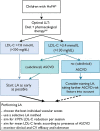This is a preprint.
Clinical practice recommendations on lipoprotein apheresis for children with homozygous familial hypercholesterolemia: an expert consensus statement from ERKNet and ESPN
- PMID: 38014132
- PMCID: PMC10680892
- DOI: 10.1101/2023.11.14.23298547
Clinical practice recommendations on lipoprotein apheresis for children with homozygous familial hypercholesterolemia: an expert consensus statement from ERKNet and ESPN
Update in
-
Clinical practice recommendations on lipoprotein apheresis for children with homozygous familial hypercholesterolaemia: An expert consensus statement from ERKNet and ESPN.Atherosclerosis. 2024 May;392:117525. doi: 10.1016/j.atherosclerosis.2024.117525. Epub 2024 Mar 27. Atherosclerosis. 2024. PMID: 38598969 Review.
Abstract
Homozygous familial hypercholesterolaemia is a life-threatening genetic condition, which causes extremely elevated LDL-C levels and atherosclerotic cardiovascular disease very early in life. It is vital to start effective lipid-lowering treatment from diagnosis onwards. Even with dietary and current multimodal pharmaceutical lipid-lowering therapies, LDL-C treatment goals cannot be achieved in many children. Lipoprotein apheresis is an extracorporeal lipid-lowering treatment, which is well established since three decades, lowering serum LDL-C levels by more than 70% per session. Data on the use of lipoprotein apheresis in children with homozygous familial hypercholesterolaemia mainly consists of case-reports and case-series, precluding strong evidence-based guidelines. We present a consensus statement on lipoprotein apheresis in children based on the current available evidence and opinions from experts in lipoprotein apheresis from over the world. It comprises practical statements regarding the indication, methods, treatment targets and follow-up of lipoprotein apheresis in children with homozygous familial hypercholesterolaemia and on the role of lipoprotein(a) and liver transplantation.
Keywords: LDL; cholesterol; consensus statement; homozygous familial hypercholesterolemia; lipoprotein apheresis; paediatrics.
Similar articles
-
Clinical practice recommendations on lipoprotein apheresis for children with homozygous familial hypercholesterolaemia: An expert consensus statement from ERKNet and ESPN.Atherosclerosis. 2024 May;392:117525. doi: 10.1016/j.atherosclerosis.2024.117525. Epub 2024 Mar 27. Atherosclerosis. 2024. PMID: 38598969 Review.
-
Low-density lipoprotein apheresis: an evidence-based analysis.Ont Health Technol Assess Ser. 2007;7(5):1-101. Epub 2006 Nov 1. Ont Health Technol Assess Ser. 2007. PMID: 23074505 Free PMC article.
-
Current view: indications for extracorporeal lipid apheresis treatment.Clin Res Cardiol Suppl. 2012 Jun;7(Suppl 1):15-9. doi: 10.1007/s11789-012-0046-6. Clin Res Cardiol Suppl. 2012. PMID: 22528134 Free PMC article.
-
Apheresis: What Should a Clinician Know?Curr Atheroscler Rep. 2023 Mar;25(3):77-83. doi: 10.1007/s11883-023-01081-7. Epub 2023 Jan 26. Curr Atheroscler Rep. 2023. PMID: 36701088 Free PMC article. Review.
-
Homozygous familial hypercholesterolaemia: update on management.Paediatr Int Child Health. 2016 Nov;36(4):243-247. doi: 10.1080/20469047.2016.1246640. Paediatr Int Child Health. 2016. PMID: 27967828 Review.
Cited by
-
The relationship between klotho, testosterone, and sexual health parameters among US adult men.J Endocrinol Invest. 2024 Mar;47(3):523-533. doi: 10.1007/s40618-023-02163-8. Epub 2023 Aug 30. J Endocrinol Invest. 2024. PMID: 37648906
References
-
- Cuchel M, Raal FJ, Hegele RA, Al-Rasadi K, Arca M, Averna M, et al. 2023 Update on European Atherosclerosis Society Consensus Statement on Homozygous Familial Hypercholesterolaemia: new treatments and clinical guidance. Eur Heart J 2023;44(25):2277–2291. doi: 10.1093/eurheartj/ehad197 - DOI - PMC - PubMed
-
- Tromp TR, Hartgers ML, Hovingh GK, Blom DJ, Cuchel M, Raal FJ. Worldwide perspective on homozygous familial hypercholesterolemia diagnosis, treatment and outcome – results from the HICC registry. Atherosclerosis 2021;331:e180–e1. doi: 10.1016/j.atherosclerosis.2021.06.549 - DOI
-
- Luirink IK, Hutten BA, Greber-Platzer S, Kolovou GD, Dann EJ, de Ferranti SD, et al. Practice of lipoprotein apheresis and short-term efficacy in children with homozygous familial hypercholesterolemia: Data from an international registry. Atherosclerosis 2020;299:24–31. doi: 10.1016/j.atherosclerosis.2020.01.031 - DOI - PubMed
-
- Víšek J, Bláha M, Bláha V, Lášticová M, Lánska M, Andrýs C, et al. Monitoring of up to 15 years effects of lipoprotein apheresis on lipids, biomarkers of inflammation, and soluble endoglin in familial hypercholesterolemia patients. Orphanet J Rare Dis 2021;16(1):110. doi: 10.1186/s13023-021-01749-w - DOI - PMC - PubMed
Publication types
Grants and funding
LinkOut - more resources
Full Text Sources

